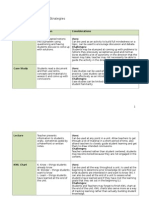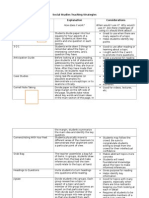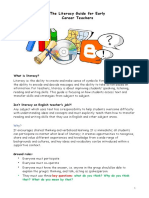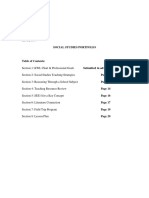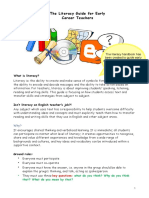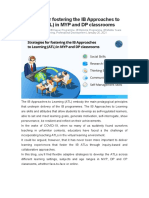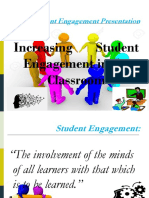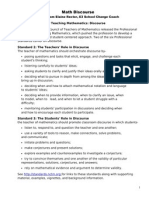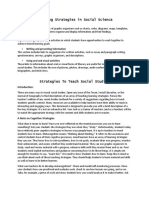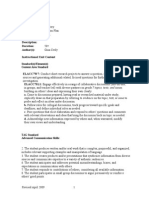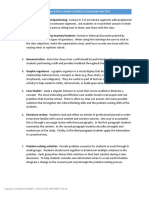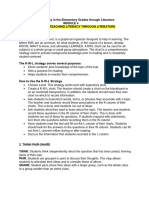Professional Documents
Culture Documents
Ten Ideas For Small Group Work in The R.E. Classroom Booklet
Ten Ideas For Small Group Work in The R.E. Classroom Booklet
Uploaded by
AmeyRuled AriffinOriginal Description:
Original Title
Copyright
Available Formats
Share this document
Did you find this document useful?
Is this content inappropriate?
Report this DocumentCopyright:
Available Formats
Ten Ideas For Small Group Work in The R.E. Classroom Booklet
Ten Ideas For Small Group Work in The R.E. Classroom Booklet
Uploaded by
AmeyRuled AriffinCopyright:
Available Formats
Ten Ideas for Small Group Work in the R.E.
Classroom
Use these as appropriate to the activity, subject and class. 1. Think Pair Share
Think Pair Share can be used to help students: recall events make a summary stimulate thinking share responses, feelings and ideas How to The teacher sets a problem/task or asks for a response to the reading/material. The students think alone for a specified time. The students form pairs to discuss the problem or give responses. Some responses may be shared with the class. Discuss the rights and responsibilities of speakers and listeners so that students gain from the partner discussions. Talk about and model behaviours that are expected when people speak and listen to each other. Point out those who have successful discussions so that students understand exactly what they need to do.
2. Round Robin
Students give their opinions verbally around the circle or group. All members contribute equally.
3. Placemat and Round Robin
This activity is designed to allow for each individuals thinking, perspective and voice to be heard, recognised and explored. It is useful for situations where you want student discussion and input from all. 1. Form participants into groups of four. 2. Give one piece of A3 paper (or large sheet) to each group. 3. Ask each group to draw the diagram on the paper.
4. Each participant writes their thoughts about the topic in the outer spaces. 5. Conduct a Round Robin so that each participant can share their views.
6. A nominated scribe notes down the common points made by each participant in the circle in the middle. 7. Each group then reports the common points to the whole class group.
4. PMI
A PMI (Plus, Minus, Interesting) is used to get students opinions, viewpoints etc. It encourages students to talk about the pluses, minuses and interesting points felt about a lesson, concept or issue.
What I liked Pluses (+) What I didnt like Minuses (-) What I thought was interesting Questions or thoughts
5. Jigsaw
In this activity, participants within a cooperative group each become expert on different aspects of one topic of study. It is also useful as an approach to tackling large selections of material which students need to read and understand. 1. Each group is assigned a task or topic. They may be individuals from different cooperative groups who have the same assigned topic. 2. Together, this expert group studies their topic and plan effective ways to teach important information when they return to their cooperative groups. 3. One way of teaching is for the expert group to display their information on paper, or they may decide how to summarise main points, key arguments etc. 4. Participants return to their cooperative groups and teach all members of their group as they are now the experts.
6. Venn Diagram (comparison)
Venn diagrams support students to identify similarities and differences between ideas, concepts or problems. The similarities are recorded in the intersection of the two circles. The differences are recorded in the outer sections of the two circles.
7. T Charts T Charts are used to examine a particular problem or issue. They can be used to explore effective listening skills. T Chart (cause and effect) Cause Effect
T Chart (problem/solution) Problem Solution
8. Y Charts Y Charts are another example/an extension of T Charts. Use where you want students to explore ideas, develop understanding or make connections with what they already know.
9. Graphic Organisers Concept Webs
Concept webs (maps) encourage students to visually record their learning through exploring issues or a topic. Students establish connections and organise ideas thereby helping them to understand the relationships between different concepts, problems and ideas.
The centre circle contains the main concept, problem or topic. Linking ideas or solutions are recorded in the outer circles through the use of key words. Lines may be added to link the connecting circles to each other as well as to the central circle. Images and colours may also be used to enhance the concept map.
10.
Numbered Heads
Students are numbered off by the teacher, eg 1-6. Three/ four or more different types of card may be handed around the room and students grouped according to the colour of the card. This is useful for organising cooperative strategies such as jigsaws.
You might also like
- Graffiti Model Lesson PlanDocument9 pagesGraffiti Model Lesson Planapi-286619177100% (1)
- 8 Types of Graphic Organizers For Social StudiesDocument12 pages8 Types of Graphic Organizers For Social StudiesEmmanuel Gabriel Catalan Doroja100% (2)
- 08a Evidence PlanDocument4 pages08a Evidence Planjessicaduetes100% (1)
- Teaching Strats PortfolioDocument21 pagesTeaching Strats Portfolioapi-265908930No ratings yet
- Starter Worksheet - Equivalent FractionsDocument2 pagesStarter Worksheet - Equivalent FractionsAmeyRuled AriffinNo ratings yet
- Equivalent Fractions Interview Lesson (Dec 2010)Document1 pageEquivalent Fractions Interview Lesson (Dec 2010)AmeyRuled AriffinNo ratings yet
- Math 323: Solutions To Homework 9Document8 pagesMath 323: Solutions To Homework 9AlbertoAlcaláNo ratings yet
- Ten Ideas For Small Group Work in The R.E. Classroom BookletDocument8 pagesTen Ideas For Small Group Work in The R.E. Classroom BookletLeslie TokzNo ratings yet
- Social Studies Teaching StrategiesDocument12 pagesSocial Studies Teaching Strategiesapi-266063796100% (1)
- Teaching StrategiesDocument34 pagesTeaching Strategiesalfredyanga08No ratings yet
- Social Studies Teaching StrategiesDocument4 pagesSocial Studies Teaching Strategiesapi-280000855No ratings yet
- Teaching Strategies and 4a's LPDocument5 pagesTeaching Strategies and 4a's LPJonessa Heartifilia100% (5)
- Literacy HandbookDocument16 pagesLiteracy Handbookapi-299191866No ratings yet
- Lesson7 VisualDocument4 pagesLesson7 VisualMount CarmelNo ratings yet
- Sims PortfolioDocument24 pagesSims Portfolioapi-240050520No ratings yet
- Literacy HandbookDocument16 pagesLiteracy Handbookapi-299191866No ratings yet
- G 2ft StrategiesDocument3 pagesG 2ft Strategiesapi-395291571No ratings yet
- Strategies For Fostering The IB Approaches To LearningDocument8 pagesStrategies For Fostering The IB Approaches To LearningArielNo ratings yet
- Strategies For Fostering The IB Approaches To Learning (ATL) in MYP and DP ClassroomsDocument8 pagesStrategies For Fostering The IB Approaches To Learning (ATL) in MYP and DP ClassroomsArielNo ratings yet
- Circle TalkDocument2 pagesCircle TalkJollyGay Tautoan LadoresNo ratings yet
- Classroom Modeling - PhippsDocument8 pagesClassroom Modeling - Phippsapi-399906068No ratings yet
- Interview or Role PlayDocument24 pagesInterview or Role PlayRolly Aquino SubionNo ratings yet
- Avid Instruction Strategies PDFDocument3 pagesAvid Instruction Strategies PDFKate GrunowNo ratings yet
- Teaching Strate-WPS OfficeDocument7 pagesTeaching Strate-WPS OfficeKent MarianitoNo ratings yet
- Semantic Mapping UniDocument7 pagesSemantic Mapping UniNatalia SerranoNo ratings yet
- BrainstormingDocument11 pagesBrainstormingSuzette MiagaNo ratings yet
- Interactive Classroom ActivitiesDocument21 pagesInteractive Classroom ActivitiesNatasha FrancisNo ratings yet
- 5 Teaching StrategiesDocument10 pages5 Teaching StrategiesPrince GitganoNo ratings yet
- How Do You Effectively Engage Your Students in LearningDocument22 pagesHow Do You Effectively Engage Your Students in LearningKim B. AlcanceNo ratings yet
- Math Best PracticesDocument5 pagesMath Best Practicesmcuzsay_92No ratings yet
- Brainstorming - A Planning GuideDocument4 pagesBrainstorming - A Planning GuideIlene Dawn AlexanderNo ratings yet
- INSTRUCTIONAL STRATEGIES To PrintDocument5 pagesINSTRUCTIONAL STRATEGIES To PrintChe SalveronNo ratings yet
- Collaborative Learning Is An Educational Approach To Teaching and Learning That Involves Groups of Learners Working Together To Solve A ProblemDocument5 pagesCollaborative Learning Is An Educational Approach To Teaching and Learning That Involves Groups of Learners Working Together To Solve A ProblemECE CAPILINo ratings yet
- 06 - TEACHING-STRATEGIES-SEMINAR-final-1 (GLENNY's Conflicted Copy 2015-11-09)Document63 pages06 - TEACHING-STRATEGIES-SEMINAR-final-1 (GLENNY's Conflicted Copy 2015-11-09)JENNIFER LEDESMA-PIDO100% (1)
- Think Pair ShareDocument3 pagesThink Pair ShareAuliaNo ratings yet
- Teaching StrategiesDocument34 pagesTeaching StrategiesIvy Villanueva DivinoNo ratings yet
- Teaching StrategiesDocument5 pagesTeaching StrategiesJay JayNo ratings yet
- Worksheet Jigsaw 1Document10 pagesWorksheet Jigsaw 1Adelina ShafetsilaNo ratings yet
- Jauregui Teaching Strategy TemplatesDocument10 pagesJauregui Teaching Strategy Templatesapi-249809981No ratings yet
- Social SkillsDocument4 pagesSocial Skillsapi-222112257No ratings yet
- Galler WalkDocument13 pagesGaller Walkapi-347025390No ratings yet
- Creative Thinking & Creative Problem Solving SkillsDocument5 pagesCreative Thinking & Creative Problem Solving Skillsapi-262029906No ratings yet
- Debate and Discussion Formats: Pair TalkDocument4 pagesDebate and Discussion Formats: Pair TalkIsham IbrahimNo ratings yet
- Cooperative Learning StrategiesDocument33 pagesCooperative Learning StrategiesJun JieNo ratings yet
- Learning Style Assessment ToolDocument4 pagesLearning Style Assessment ToolAntolyn DediosNo ratings yet
- Teaching Strategies in Social ScienceDocument4 pagesTeaching Strategies in Social ScienceKaren Calderon FloresNo ratings yet
- 04-Formative StrategiesDocument3 pages04-Formative StrategiesMichelle StockdaleNo ratings yet
- Effective Communication in Teaching and Learning of MathematicsDocument52 pagesEffective Communication in Teaching and Learning of MathematicsHeidi JorxNo ratings yet
- Mystery Lesson PlanDocument5 pagesMystery Lesson Planapi-284385297100% (1)
- Let's Focus On LearnersDocument4 pagesLet's Focus On LearnersdowjonesNo ratings yet
- Interactive NotebookDocument13 pagesInteractive Notebookapi-438474588No ratings yet
- WEEK 6 and 8 Cooperative Learning and Concept Mapping Spring 2012Document34 pagesWEEK 6 and 8 Cooperative Learning and Concept Mapping Spring 2012Faysal JemaiNo ratings yet
- Reading Activities TrainingDocument11 pagesReading Activities TrainingIsrael GarciaNo ratings yet
- Mathlessonplan 1Document4 pagesMathlessonplan 1api-311884545100% (1)
- Advance Science TeachingDocument27 pagesAdvance Science TeachingRio De VeraNo ratings yet
- Cooperative Learning Lesson Plan 542Document6 pagesCooperative Learning Lesson Plan 542api-347023972No ratings yet
- SDAIE StrategiesDocument9 pagesSDAIE StrategiesGon FloNo ratings yet
- Module-4 (Te2)Document12 pagesModule-4 (Te2)Joanne LorenzoNo ratings yet
- Cooperative LearningDocument15 pagesCooperative LearningTerry DoyleNo ratings yet
- 32 Teaching Strategies in MathDocument35 pages32 Teaching Strategies in Matheinsteinspy100% (1)
- Collaborative Strategic ReadingDocument5 pagesCollaborative Strategic ReadingFebry Daulays100% (1)
- Informational Text Toolkit: Research-based Strategies for the Common Core StandardsFrom EverandInformational Text Toolkit: Research-based Strategies for the Common Core StandardsNo ratings yet
- Four Related Number Facts (2) : NameDocument1 pageFour Related Number Facts (2) : NameAmeyRuled AriffinNo ratings yet
- PMI Model EbuttDocument1 pagePMI Model EbuttAmeyRuled AriffinNo ratings yet
- Face Config GuideDocument1 pageFace Config GuideAmeyRuled AriffinNo ratings yet
- Slobs Lamps: Maller Arger FF Orrow UbtractDocument2 pagesSlobs Lamps: Maller Arger FF Orrow UbtractAmeyRuled AriffinNo ratings yet
- Student Name: - ScoreDocument2 pagesStudent Name: - ScoreAmeyRuled AriffinNo ratings yet
- Addition and Subtraction Opposites: - Complete The Following Using CubesDocument1 pageAddition and Subtraction Opposites: - Complete The Following Using CubesAmeyRuled AriffinNo ratings yet
- 10 RujukanDocument2 pages10 RujukanAmeyRuled AriffinNo ratings yet
- TranslateDocument3 pagesTranslateAmeyRuled AriffinNo ratings yet
- Pupil WorksheetDocument2 pagesPupil WorksheetAmeyRuled AriffinNo ratings yet
- Frostburn's WrathDocument2 pagesFrostburn's WrathToucanBuzzNo ratings yet
- Guideline - Hygienic Design - May 2021Document27 pagesGuideline - Hygienic Design - May 2021Akhila MpNo ratings yet
- Mandala OfferingDocument3 pagesMandala Offeringctan014No ratings yet
- Con CallDocument22 pagesCon Callsachinaman.2016No ratings yet
- Esab Caddy Tig-2200i Ac-Dc 718-xxx To 843-xxxDocument64 pagesEsab Caddy Tig-2200i Ac-Dc 718-xxx To 843-xxxhitano12100% (1)
- 1 nl24xDocument11 pages1 nl24xhumbertoNo ratings yet
- Profile Bhavani Electricals-1Document22 pagesProfile Bhavani Electricals-1Kumar RaoNo ratings yet
- KRS-HSE-PSD-16 Lifting Equipment and Gears - Rev. 01Document20 pagesKRS-HSE-PSD-16 Lifting Equipment and Gears - Rev. 01Asensio SinagaNo ratings yet
- Repair Manual PDFDocument16 pagesRepair Manual PDFDianNo ratings yet
- Valsartan + HydrochlorotiazideDocument17 pagesValsartan + Hydrochlorotiazideddandan_2No ratings yet
- Task Comparatives and SuperlativesDocument2 pagesTask Comparatives and SuperlativesMarcela Marin RosalesNo ratings yet
- Final PPT - REfDocument26 pagesFinal PPT - REfashishvasekarNo ratings yet
- The Body in The Music Epistemology and Musical SemioticsDocument11 pagesThe Body in The Music Epistemology and Musical SemioticsAnonymous LyxcVo100% (1)
- Front Matter 2023 Dynamics of Plate Tectonics and Mantle ConvectionDocument10 pagesFront Matter 2023 Dynamics of Plate Tectonics and Mantle ConvectionScribd_is_GreatNo ratings yet
- Summative Test Music 8 2ND QuarterDocument2 pagesSummative Test Music 8 2ND QuarterIverAlambraNo ratings yet
- Book 1Document4 pagesBook 1mian rehmanNo ratings yet
- Review of Related LiteratureDocument30 pagesReview of Related LiteratureBryan Aguila BautistaNo ratings yet
- Probablility Notes Week 3Document8 pagesProbablility Notes Week 3Anant RamdialNo ratings yet
- Yamaha: Owner's ManualDocument40 pagesYamaha: Owner's ManualsugenkNo ratings yet
- Ug CBCSDocument9 pagesUg CBCSLalchand AliNo ratings yet
- Inquisitor DPS:: Strength: This Affects Your Autoattack Damage As Well As The Up-Front Damage ofDocument9 pagesInquisitor DPS:: Strength: This Affects Your Autoattack Damage As Well As The Up-Front Damage ofrarenomadNo ratings yet
- Painting - Realism, Impressionism and BeyondDocument5 pagesPainting - Realism, Impressionism and BeyondBGRNo ratings yet
- The Effect of Contract Type and Size On Competitivness in Construction Contract BiddingDocument426 pagesThe Effect of Contract Type and Size On Competitivness in Construction Contract BiddingElliot MortonNo ratings yet
- UJF-3042HG UJF-6042 OperationManual PDFDocument158 pagesUJF-3042HG UJF-6042 OperationManual PDFJorge Caicedo Frv LfuNo ratings yet
- Detector III - Technical Info 2013Document15 pagesDetector III - Technical Info 2013Munkhnasan MonaNo ratings yet
- Prepared By: Zeinab Khaled, Grade 11, AIADocument3 pagesPrepared By: Zeinab Khaled, Grade 11, AIAkhNo ratings yet
- Interview With Oyinkan Adewale, Executive Director - Chief Financial Officer, Oceanic Bank International PLC On Q2 2010 ResultsDocument9 pagesInterview With Oyinkan Adewale, Executive Director - Chief Financial Officer, Oceanic Bank International PLC On Q2 2010 ResultsOceanic Bank International PLCNo ratings yet
- Pediatric Diabetic Ketoacidosis With Hyperosmolarity: Clinical Characteristics and Outcomes - EndocrDocument1 pagePediatric Diabetic Ketoacidosis With Hyperosmolarity: Clinical Characteristics and Outcomes - EndocrSagar PatelNo ratings yet









